Nursing Essay: Epidemiology, Challenges, and Tuberculosis Pandemic
VerifiedAdded on 2020/12/30
|9
|2583
|105
Essay
AI Summary
This essay provides a detailed overview of the global tuberculosis pandemic, focusing on its epidemiology, causes, and distribution. It discusses the significant impact of the disease, including mortality rates and the countries most affected. The essay examines the role of nurses in managing and controlling the spread of tuberculosis, highlighting the challenges they face in preparing for pandemic emergencies, such as issues of transmission and infection control. Furthermore, it explores the importance of specialist nurses in patient monitoring, treatment adherence, and liaising with relevant agencies. The essay emphasizes the need for effective surveillance systems, tailored approaches, and protective measures like mask-wearing and vaccination to control the disease. The conclusion underscores the critical role of nurses in protecting public health during the pandemic and the necessity of addressing challenges related to patient care and infection control.

NURSING
Paraphrase This Document
Need a fresh take? Get an instant paraphrase of this document with our AI Paraphraser
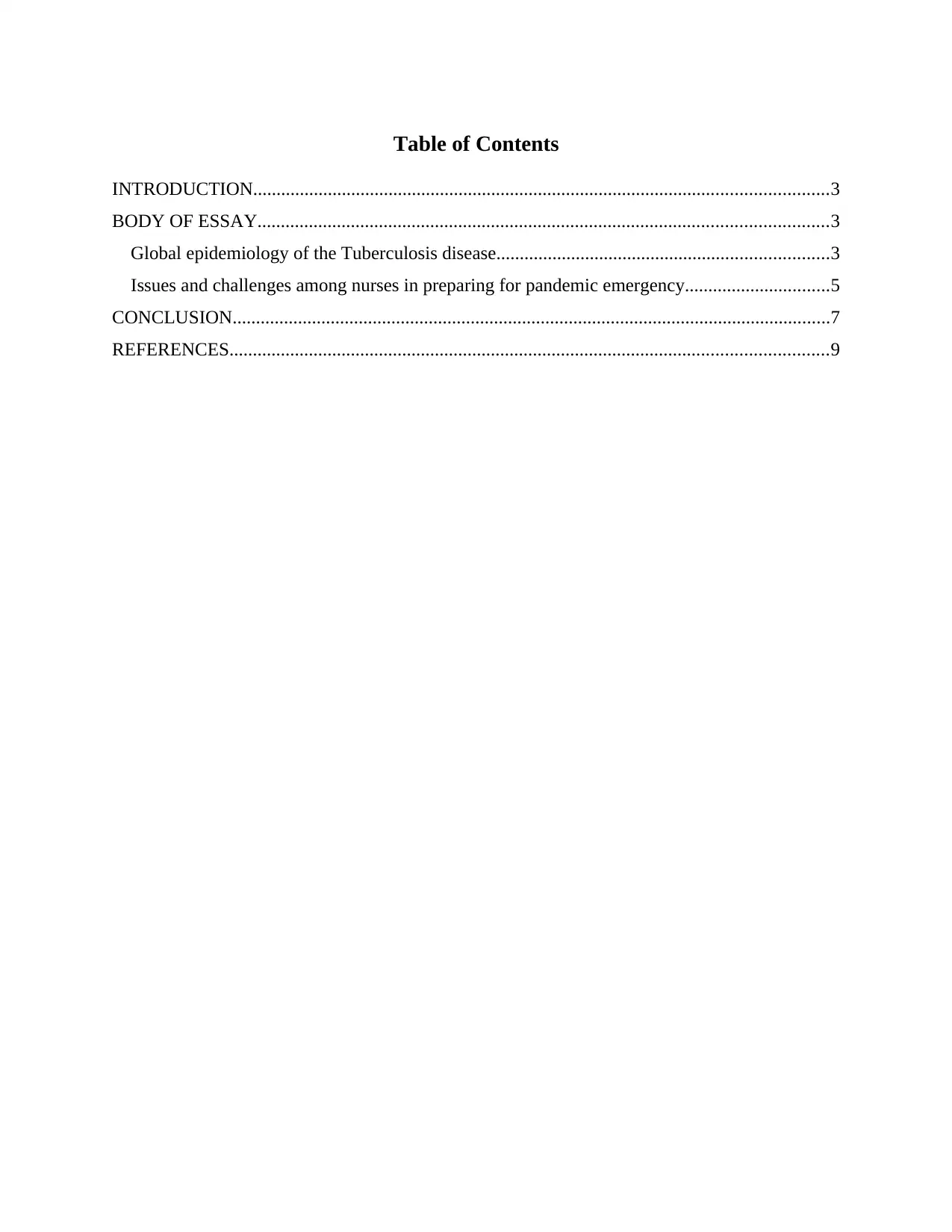
Table of Contents
INTRODUCTION...........................................................................................................................3
BODY OF ESSAY..........................................................................................................................3
Global epidemiology of the Tuberculosis disease.......................................................................3
Issues and challenges among nurses in preparing for pandemic emergency...............................5
CONCLUSION................................................................................................................................7
REFERENCES................................................................................................................................9
INTRODUCTION...........................................................................................................................3
BODY OF ESSAY..........................................................................................................................3
Global epidemiology of the Tuberculosis disease.......................................................................3
Issues and challenges among nurses in preparing for pandemic emergency...............................5
CONCLUSION................................................................................................................................7
REFERENCES................................................................................................................................9
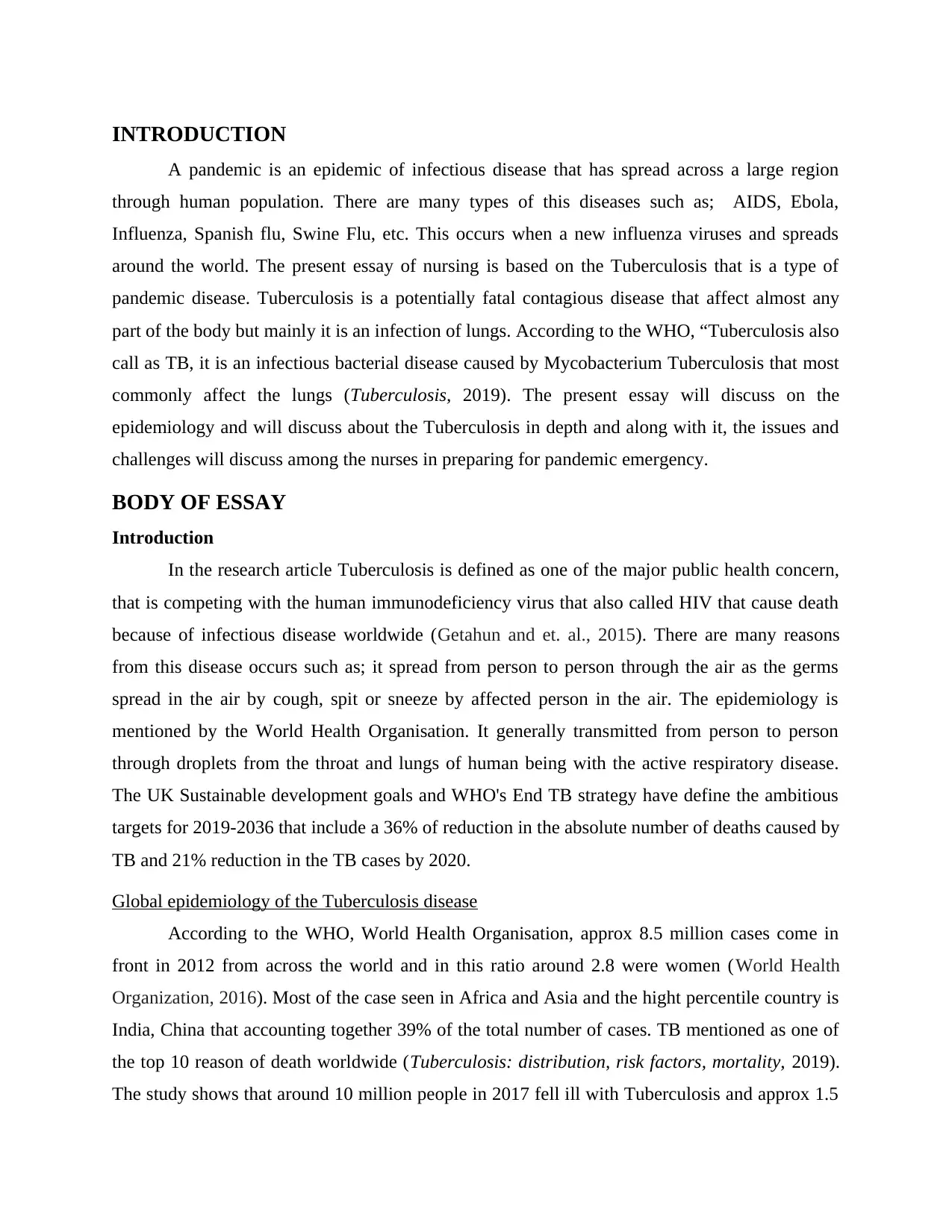
INTRODUCTION
A pandemic is an epidemic of infectious disease that has spread across a large region
through human population. There are many types of this diseases such as; AIDS, Ebola,
Influenza, Spanish flu, Swine Flu, etc. This occurs when a new influenza viruses and spreads
around the world. The present essay of nursing is based on the Tuberculosis that is a type of
pandemic disease. Tuberculosis is a potentially fatal contagious disease that affect almost any
part of the body but mainly it is an infection of lungs. According to the WHO, “Tuberculosis also
call as TB, it is an infectious bacterial disease caused by Mycobacterium Tuberculosis that most
commonly affect the lungs (Tuberculosis, 2019). The present essay will discuss on the
epidemiology and will discuss about the Tuberculosis in depth and along with it, the issues and
challenges will discuss among the nurses in preparing for pandemic emergency.
BODY OF ESSAY
Introduction
In the research article Tuberculosis is defined as one of the major public health concern,
that is competing with the human immunodeficiency virus that also called HIV that cause death
because of infectious disease worldwide (Getahun and et. al., 2015). There are many reasons
from this disease occurs such as; it spread from person to person through the air as the germs
spread in the air by cough, spit or sneeze by affected person in the air. The epidemiology is
mentioned by the World Health Organisation. It generally transmitted from person to person
through droplets from the throat and lungs of human being with the active respiratory disease.
The UK Sustainable development goals and WHO's End TB strategy have define the ambitious
targets for 2019-2036 that include a 36% of reduction in the absolute number of deaths caused by
TB and 21% reduction in the TB cases by 2020.
Global epidemiology of the Tuberculosis disease
According to the WHO, World Health Organisation, approx 8.5 million cases come in
front in 2012 from across the world and in this ratio around 2.8 were women (World Health
Organization, 2016). Most of the case seen in Africa and Asia and the hight percentile country is
India, China that accounting together 39% of the total number of cases. TB mentioned as one of
the top 10 reason of death worldwide (Tuberculosis: distribution, risk factors, mortality, 2019).
The study shows that around 10 million people in 2017 fell ill with Tuberculosis and approx 1.5
A pandemic is an epidemic of infectious disease that has spread across a large region
through human population. There are many types of this diseases such as; AIDS, Ebola,
Influenza, Spanish flu, Swine Flu, etc. This occurs when a new influenza viruses and spreads
around the world. The present essay of nursing is based on the Tuberculosis that is a type of
pandemic disease. Tuberculosis is a potentially fatal contagious disease that affect almost any
part of the body but mainly it is an infection of lungs. According to the WHO, “Tuberculosis also
call as TB, it is an infectious bacterial disease caused by Mycobacterium Tuberculosis that most
commonly affect the lungs (Tuberculosis, 2019). The present essay will discuss on the
epidemiology and will discuss about the Tuberculosis in depth and along with it, the issues and
challenges will discuss among the nurses in preparing for pandemic emergency.
BODY OF ESSAY
Introduction
In the research article Tuberculosis is defined as one of the major public health concern,
that is competing with the human immunodeficiency virus that also called HIV that cause death
because of infectious disease worldwide (Getahun and et. al., 2015). There are many reasons
from this disease occurs such as; it spread from person to person through the air as the germs
spread in the air by cough, spit or sneeze by affected person in the air. The epidemiology is
mentioned by the World Health Organisation. It generally transmitted from person to person
through droplets from the throat and lungs of human being with the active respiratory disease.
The UK Sustainable development goals and WHO's End TB strategy have define the ambitious
targets for 2019-2036 that include a 36% of reduction in the absolute number of deaths caused by
TB and 21% reduction in the TB cases by 2020.
Global epidemiology of the Tuberculosis disease
According to the WHO, World Health Organisation, approx 8.5 million cases come in
front in 2012 from across the world and in this ratio around 2.8 were women (World Health
Organization, 2016). Most of the case seen in Africa and Asia and the hight percentile country is
India, China that accounting together 39% of the total number of cases. TB mentioned as one of
the top 10 reason of death worldwide (Tuberculosis: distribution, risk factors, mortality, 2019).
The study shows that around 10 million people in 2017 fell ill with Tuberculosis and approx 1.5
⊘ This is a preview!⊘
Do you want full access?
Subscribe today to unlock all pages.

Trusted by 1+ million students worldwide
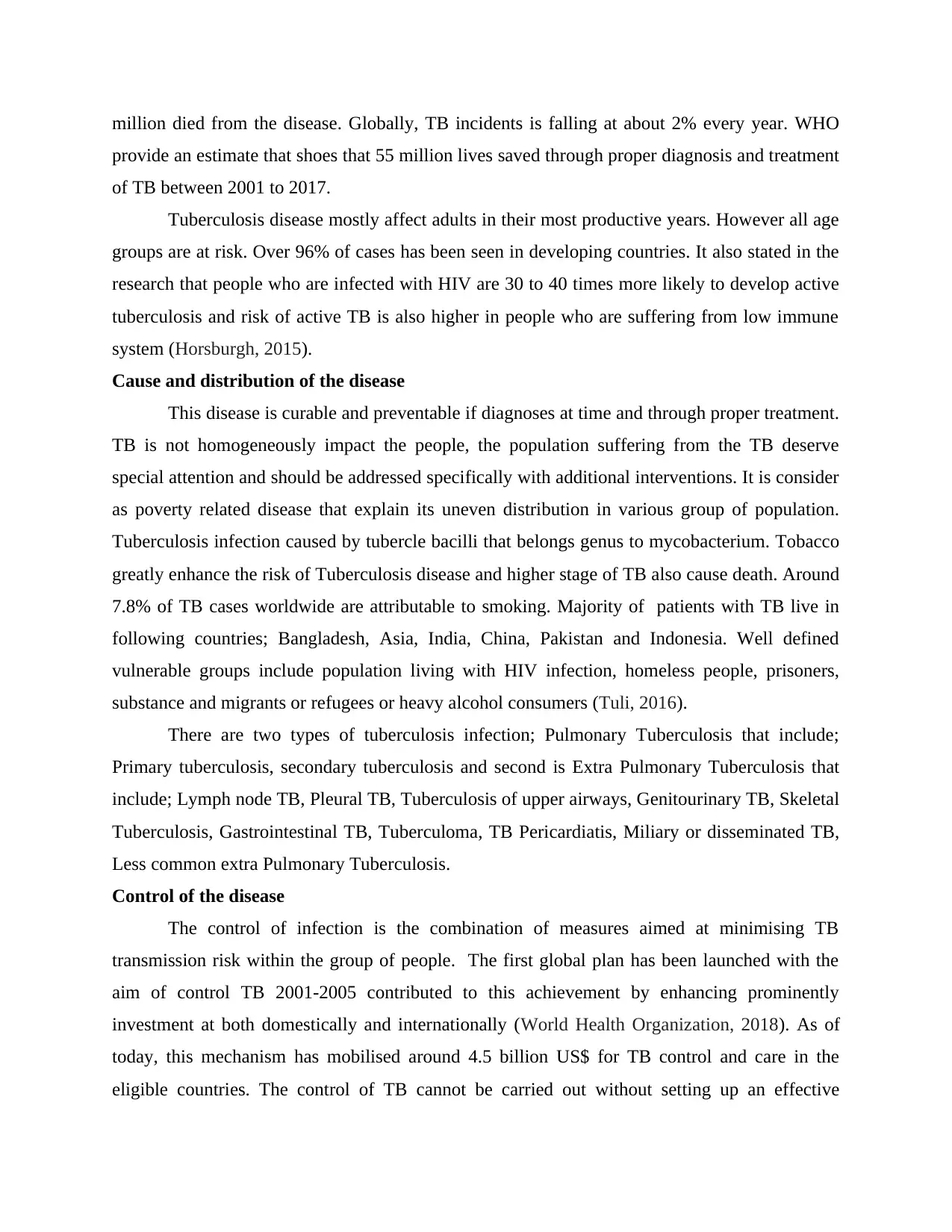
million died from the disease. Globally, TB incidents is falling at about 2% every year. WHO
provide an estimate that shoes that 55 million lives saved through proper diagnosis and treatment
of TB between 2001 to 2017.
Tuberculosis disease mostly affect adults in their most productive years. However all age
groups are at risk. Over 96% of cases has been seen in developing countries. It also stated in the
research that people who are infected with HIV are 30 to 40 times more likely to develop active
tuberculosis and risk of active TB is also higher in people who are suffering from low immune
system (Horsburgh, 2015).
Cause and distribution of the disease
This disease is curable and preventable if diagnoses at time and through proper treatment.
TB is not homogeneously impact the people, the population suffering from the TB deserve
special attention and should be addressed specifically with additional interventions. It is consider
as poverty related disease that explain its uneven distribution in various group of population.
Tuberculosis infection caused by tubercle bacilli that belongs genus to mycobacterium. Tobacco
greatly enhance the risk of Tuberculosis disease and higher stage of TB also cause death. Around
7.8% of TB cases worldwide are attributable to smoking. Majority of patients with TB live in
following countries; Bangladesh, Asia, India, China, Pakistan and Indonesia. Well defined
vulnerable groups include population living with HIV infection, homeless people, prisoners,
substance and migrants or refugees or heavy alcohol consumers (Tuli, 2016).
There are two types of tuberculosis infection; Pulmonary Tuberculosis that include;
Primary tuberculosis, secondary tuberculosis and second is Extra Pulmonary Tuberculosis that
include; Lymph node TB, Pleural TB, Tuberculosis of upper airways, Genitourinary TB, Skeletal
Tuberculosis, Gastrointestinal TB, Tuberculoma, TB Pericardiatis, Miliary or disseminated TB,
Less common extra Pulmonary Tuberculosis.
Control of the disease
The control of infection is the combination of measures aimed at minimising TB
transmission risk within the group of people. The first global plan has been launched with the
aim of control TB 2001-2005 contributed to this achievement by enhancing prominently
investment at both domestically and internationally (World Health Organization, 2018). As of
today, this mechanism has mobilised around 4.5 billion US$ for TB control and care in the
eligible countries. The control of TB cannot be carried out without setting up an effective
provide an estimate that shoes that 55 million lives saved through proper diagnosis and treatment
of TB between 2001 to 2017.
Tuberculosis disease mostly affect adults in their most productive years. However all age
groups are at risk. Over 96% of cases has been seen in developing countries. It also stated in the
research that people who are infected with HIV are 30 to 40 times more likely to develop active
tuberculosis and risk of active TB is also higher in people who are suffering from low immune
system (Horsburgh, 2015).
Cause and distribution of the disease
This disease is curable and preventable if diagnoses at time and through proper treatment.
TB is not homogeneously impact the people, the population suffering from the TB deserve
special attention and should be addressed specifically with additional interventions. It is consider
as poverty related disease that explain its uneven distribution in various group of population.
Tuberculosis infection caused by tubercle bacilli that belongs genus to mycobacterium. Tobacco
greatly enhance the risk of Tuberculosis disease and higher stage of TB also cause death. Around
7.8% of TB cases worldwide are attributable to smoking. Majority of patients with TB live in
following countries; Bangladesh, Asia, India, China, Pakistan and Indonesia. Well defined
vulnerable groups include population living with HIV infection, homeless people, prisoners,
substance and migrants or refugees or heavy alcohol consumers (Tuli, 2016).
There are two types of tuberculosis infection; Pulmonary Tuberculosis that include;
Primary tuberculosis, secondary tuberculosis and second is Extra Pulmonary Tuberculosis that
include; Lymph node TB, Pleural TB, Tuberculosis of upper airways, Genitourinary TB, Skeletal
Tuberculosis, Gastrointestinal TB, Tuberculoma, TB Pericardiatis, Miliary or disseminated TB,
Less common extra Pulmonary Tuberculosis.
Control of the disease
The control of infection is the combination of measures aimed at minimising TB
transmission risk within the group of people. The first global plan has been launched with the
aim of control TB 2001-2005 contributed to this achievement by enhancing prominently
investment at both domestically and internationally (World Health Organization, 2018). As of
today, this mechanism has mobilised around 4.5 billion US$ for TB control and care in the
eligible countries. The control of TB cannot be carried out without setting up an effective
Paraphrase This Document
Need a fresh take? Get an instant paraphrase of this document with our AI Paraphraser
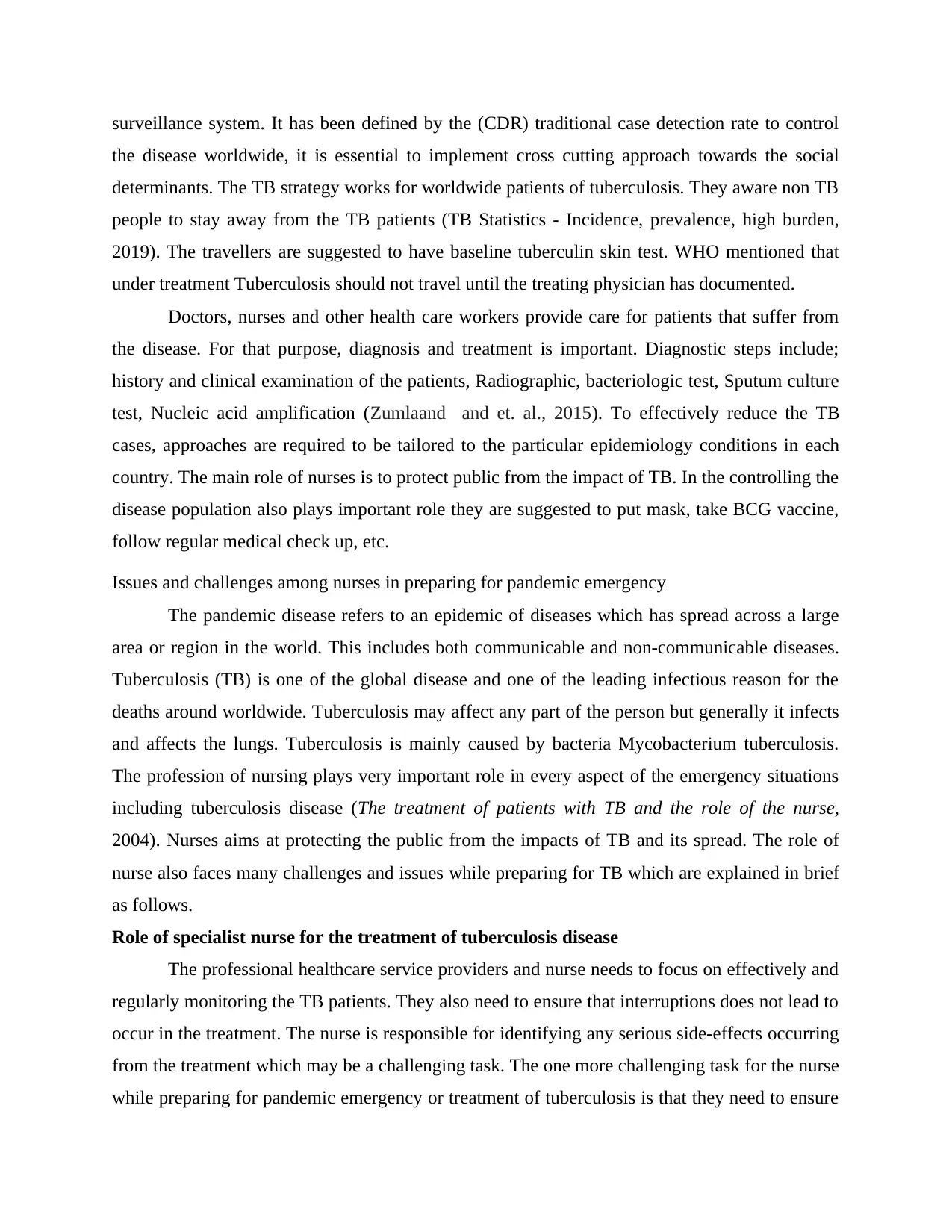
surveillance system. It has been defined by the (CDR) traditional case detection rate to control
the disease worldwide, it is essential to implement cross cutting approach towards the social
determinants. The TB strategy works for worldwide patients of tuberculosis. They aware non TB
people to stay away from the TB patients (TB Statistics - Incidence, prevalence, high burden,
2019). The travellers are suggested to have baseline tuberculin skin test. WHO mentioned that
under treatment Tuberculosis should not travel until the treating physician has documented.
Doctors, nurses and other health care workers provide care for patients that suffer from
the disease. For that purpose, diagnosis and treatment is important. Diagnostic steps include;
history and clinical examination of the patients, Radiographic, bacteriologic test, Sputum culture
test, Nucleic acid amplification (Zumlaand and et. al., 2015). To effectively reduce the TB
cases, approaches are required to be tailored to the particular epidemiology conditions in each
country. The main role of nurses is to protect public from the impact of TB. In the controlling the
disease population also plays important role they are suggested to put mask, take BCG vaccine,
follow regular medical check up, etc.
Issues and challenges among nurses in preparing for pandemic emergency
The pandemic disease refers to an epidemic of diseases which has spread across a large
area or region in the world. This includes both communicable and non-communicable diseases.
Tuberculosis (TB) is one of the global disease and one of the leading infectious reason for the
deaths around worldwide. Tuberculosis may affect any part of the person but generally it infects
and affects the lungs. Tuberculosis is mainly caused by bacteria Mycobacterium tuberculosis.
The profession of nursing plays very important role in every aspect of the emergency situations
including tuberculosis disease (The treatment of patients with TB and the role of the nurse,
2004). Nurses aims at protecting the public from the impacts of TB and its spread. The role of
nurse also faces many challenges and issues while preparing for TB which are explained in brief
as follows.
Role of specialist nurse for the treatment of tuberculosis disease
The professional healthcare service providers and nurse needs to focus on effectively and
regularly monitoring the TB patients. They also need to ensure that interruptions does not lead to
occur in the treatment. The nurse is responsible for identifying any serious side-effects occurring
from the treatment which may be a challenging task. The one more challenging task for the nurse
while preparing for pandemic emergency or treatment of tuberculosis is that they need to ensure
the disease worldwide, it is essential to implement cross cutting approach towards the social
determinants. The TB strategy works for worldwide patients of tuberculosis. They aware non TB
people to stay away from the TB patients (TB Statistics - Incidence, prevalence, high burden,
2019). The travellers are suggested to have baseline tuberculin skin test. WHO mentioned that
under treatment Tuberculosis should not travel until the treating physician has documented.
Doctors, nurses and other health care workers provide care for patients that suffer from
the disease. For that purpose, diagnosis and treatment is important. Diagnostic steps include;
history and clinical examination of the patients, Radiographic, bacteriologic test, Sputum culture
test, Nucleic acid amplification (Zumlaand and et. al., 2015). To effectively reduce the TB
cases, approaches are required to be tailored to the particular epidemiology conditions in each
country. The main role of nurses is to protect public from the impact of TB. In the controlling the
disease population also plays important role they are suggested to put mask, take BCG vaccine,
follow regular medical check up, etc.
Issues and challenges among nurses in preparing for pandemic emergency
The pandemic disease refers to an epidemic of diseases which has spread across a large
area or region in the world. This includes both communicable and non-communicable diseases.
Tuberculosis (TB) is one of the global disease and one of the leading infectious reason for the
deaths around worldwide. Tuberculosis may affect any part of the person but generally it infects
and affects the lungs. Tuberculosis is mainly caused by bacteria Mycobacterium tuberculosis.
The profession of nursing plays very important role in every aspect of the emergency situations
including tuberculosis disease (The treatment of patients with TB and the role of the nurse,
2004). Nurses aims at protecting the public from the impacts of TB and its spread. The role of
nurse also faces many challenges and issues while preparing for TB which are explained in brief
as follows.
Role of specialist nurse for the treatment of tuberculosis disease
The professional healthcare service providers and nurse needs to focus on effectively and
regularly monitoring the TB patients. They also need to ensure that interruptions does not lead to
occur in the treatment. The nurse is responsible for identifying any serious side-effects occurring
from the treatment which may be a challenging task. The one more challenging task for the nurse
while preparing for pandemic emergency or treatment of tuberculosis is that they need to ensure
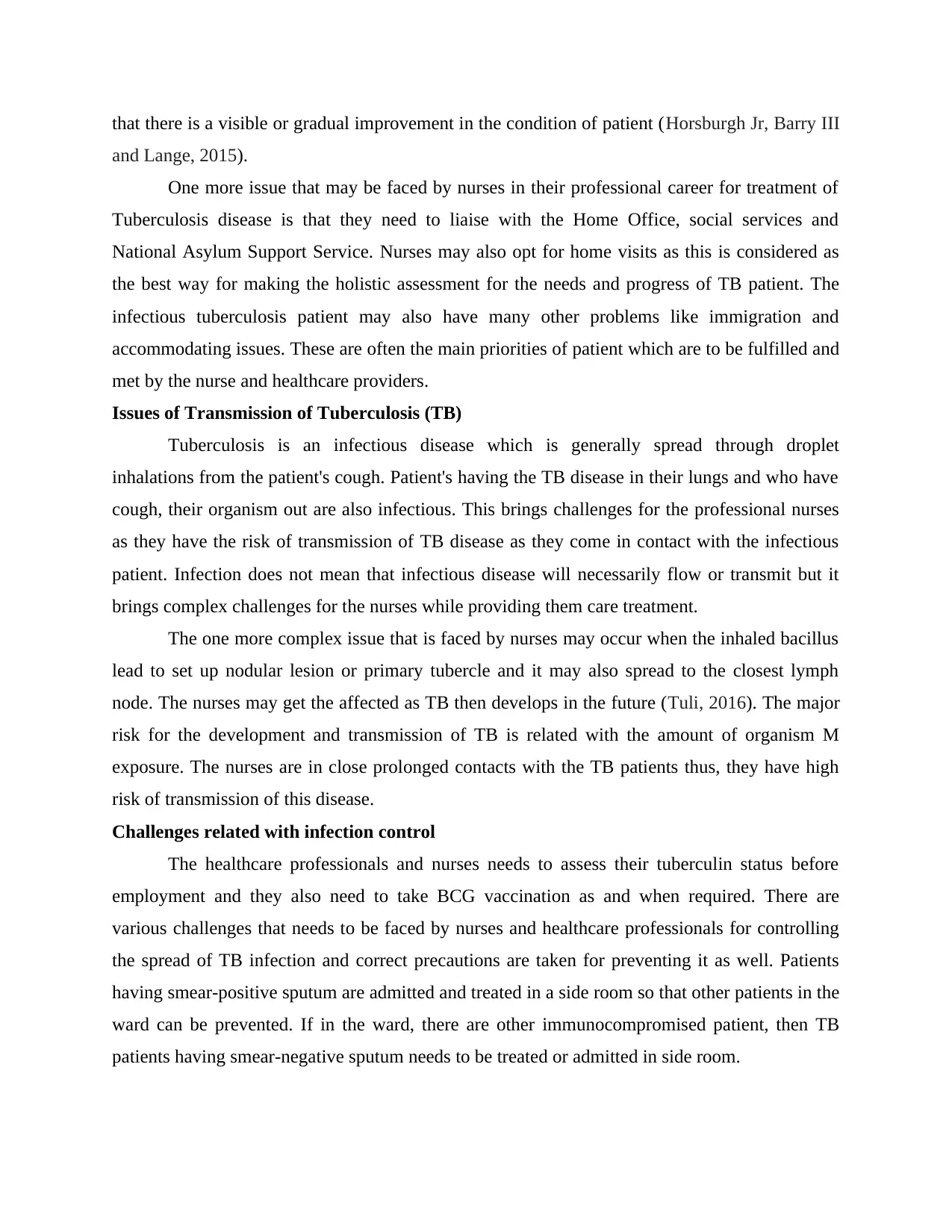
that there is a visible or gradual improvement in the condition of patient (Horsburgh Jr, Barry III
and Lange, 2015).
One more issue that may be faced by nurses in their professional career for treatment of
Tuberculosis disease is that they need to liaise with the Home Office, social services and
National Asylum Support Service. Nurses may also opt for home visits as this is considered as
the best way for making the holistic assessment for the needs and progress of TB patient. The
infectious tuberculosis patient may also have many other problems like immigration and
accommodating issues. These are often the main priorities of patient which are to be fulfilled and
met by the nurse and healthcare providers.
Issues of Transmission of Tuberculosis (TB)
Tuberculosis is an infectious disease which is generally spread through droplet
inhalations from the patient's cough. Patient's having the TB disease in their lungs and who have
cough, their organism out are also infectious. This brings challenges for the professional nurses
as they have the risk of transmission of TB disease as they come in contact with the infectious
patient. Infection does not mean that infectious disease will necessarily flow or transmit but it
brings complex challenges for the nurses while providing them care treatment.
The one more complex issue that is faced by nurses may occur when the inhaled bacillus
lead to set up nodular lesion or primary tubercle and it may also spread to the closest lymph
node. The nurses may get the affected as TB then develops in the future (Tuli, 2016). The major
risk for the development and transmission of TB is related with the amount of organism M
exposure. The nurses are in close prolonged contacts with the TB patients thus, they have high
risk of transmission of this disease.
Challenges related with infection control
The healthcare professionals and nurses needs to assess their tuberculin status before
employment and they also need to take BCG vaccination as and when required. There are
various challenges that needs to be faced by nurses and healthcare professionals for controlling
the spread of TB infection and correct precautions are taken for preventing it as well. Patients
having smear-positive sputum are admitted and treated in a side room so that other patients in the
ward can be prevented. If in the ward, there are other immunocompromised patient, then TB
patients having smear-negative sputum needs to be treated or admitted in side room.
and Lange, 2015).
One more issue that may be faced by nurses in their professional career for treatment of
Tuberculosis disease is that they need to liaise with the Home Office, social services and
National Asylum Support Service. Nurses may also opt for home visits as this is considered as
the best way for making the holistic assessment for the needs and progress of TB patient. The
infectious tuberculosis patient may also have many other problems like immigration and
accommodating issues. These are often the main priorities of patient which are to be fulfilled and
met by the nurse and healthcare providers.
Issues of Transmission of Tuberculosis (TB)
Tuberculosis is an infectious disease which is generally spread through droplet
inhalations from the patient's cough. Patient's having the TB disease in their lungs and who have
cough, their organism out are also infectious. This brings challenges for the professional nurses
as they have the risk of transmission of TB disease as they come in contact with the infectious
patient. Infection does not mean that infectious disease will necessarily flow or transmit but it
brings complex challenges for the nurses while providing them care treatment.
The one more complex issue that is faced by nurses may occur when the inhaled bacillus
lead to set up nodular lesion or primary tubercle and it may also spread to the closest lymph
node. The nurses may get the affected as TB then develops in the future (Tuli, 2016). The major
risk for the development and transmission of TB is related with the amount of organism M
exposure. The nurses are in close prolonged contacts with the TB patients thus, they have high
risk of transmission of this disease.
Challenges related with infection control
The healthcare professionals and nurses needs to assess their tuberculin status before
employment and they also need to take BCG vaccination as and when required. There are
various challenges that needs to be faced by nurses and healthcare professionals for controlling
the spread of TB infection and correct precautions are taken for preventing it as well. Patients
having smear-positive sputum are admitted and treated in a side room so that other patients in the
ward can be prevented. If in the ward, there are other immunocompromised patient, then TB
patients having smear-negative sputum needs to be treated or admitted in side room.
⊘ This is a preview!⊘
Do you want full access?
Subscribe today to unlock all pages.

Trusted by 1+ million students worldwide

There are various aspects that needs to be considered by nurse during the treatment of
epidemic disease such as tuberculosis. Such as patient suspected for having pulmonary TB needs
to be treated and nursed in the side room until obtaining of three negative smear sputum. The
nurse needs to ensure that patient remains in their rooms and also their doors are closed (Getahun
and et.al., 2015). If in any case, patient is leaving the room, they need to wear the mask.
Challenges during the infection control procedure
TB is generally spread by the droplet inhalation, thus, special cleaning of treatment
rooms following isolation for the Tuberculosis is not required. The routine infection control
procedure or routine nursing care will make nurse to wear the mask, when the TB patient have
multi drug resistant TB (MDR – TB). The one more issue related to such situation is that it is
more difficult to be treated. Patient having infectious MDR – TB needs to be nursed and treated
in the side room. The room needs to have negative pressure ventilation. The professional
healthcare service providers and nurse also needs to ensure that all the visitors and care service
providers wears a mist/dust mask in the patients room. The mask needs to meet the Personal
Protective Equipment (EC Directive) Regulations 1992 (Zumla and et. al., 2015).
Nurses and professional healthcare service providers needs to use procedure for routine
infection control in order to handle the body fluids and also the specimens. Nurses needs to
ensure that children are admitted and nursed in the side rooms and needs to screen their visitors
as well. Because the visitors may be a source for the child's disease. The nurse ensures that
affected TB patient and their relatives and visitors are provided with specialist care. The nurses
play very important and critical role in the treatment of TB patient and in liaison with the
infection control for managing and controlling the tuberculosis disease.
CONCLUSION
From the present essay it has been analysed that pandemic is a high risk disease that can
take population toward the stage of death. The risk of tuberculosis disease is higher in adults and
who smoke tobacco. From the epidemiology, it has been seen that the high rate of TB is
presented in Asia and China. There are number of issues and challenges that are faced by the
professional healthcare service providers and nurses while providing treatment to TB patients
and also preparing for pandemic emergency. The nurses treating TB patient needs to make sure
that patient are provided with correct medications and infection does no spread to other family
epidemic disease such as tuberculosis. Such as patient suspected for having pulmonary TB needs
to be treated and nursed in the side room until obtaining of three negative smear sputum. The
nurse needs to ensure that patient remains in their rooms and also their doors are closed (Getahun
and et.al., 2015). If in any case, patient is leaving the room, they need to wear the mask.
Challenges during the infection control procedure
TB is generally spread by the droplet inhalation, thus, special cleaning of treatment
rooms following isolation for the Tuberculosis is not required. The routine infection control
procedure or routine nursing care will make nurse to wear the mask, when the TB patient have
multi drug resistant TB (MDR – TB). The one more issue related to such situation is that it is
more difficult to be treated. Patient having infectious MDR – TB needs to be nursed and treated
in the side room. The room needs to have negative pressure ventilation. The professional
healthcare service providers and nurse also needs to ensure that all the visitors and care service
providers wears a mist/dust mask in the patients room. The mask needs to meet the Personal
Protective Equipment (EC Directive) Regulations 1992 (Zumla and et. al., 2015).
Nurses and professional healthcare service providers needs to use procedure for routine
infection control in order to handle the body fluids and also the specimens. Nurses needs to
ensure that children are admitted and nursed in the side rooms and needs to screen their visitors
as well. Because the visitors may be a source for the child's disease. The nurse ensures that
affected TB patient and their relatives and visitors are provided with specialist care. The nurses
play very important and critical role in the treatment of TB patient and in liaison with the
infection control for managing and controlling the tuberculosis disease.
CONCLUSION
From the present essay it has been analysed that pandemic is a high risk disease that can
take population toward the stage of death. The risk of tuberculosis disease is higher in adults and
who smoke tobacco. From the epidemiology, it has been seen that the high rate of TB is
presented in Asia and China. There are number of issues and challenges that are faced by the
professional healthcare service providers and nurses while providing treatment to TB patients
and also preparing for pandemic emergency. The nurses treating TB patient needs to make sure
that patient are provided with correct medications and infection does no spread to other family
Paraphrase This Document
Need a fresh take? Get an instant paraphrase of this document with our AI Paraphraser

members and to own-self. Nurses need to also provide support to patient and their relatives and
to prevent lapses in the treatment.
to prevent lapses in the treatment.
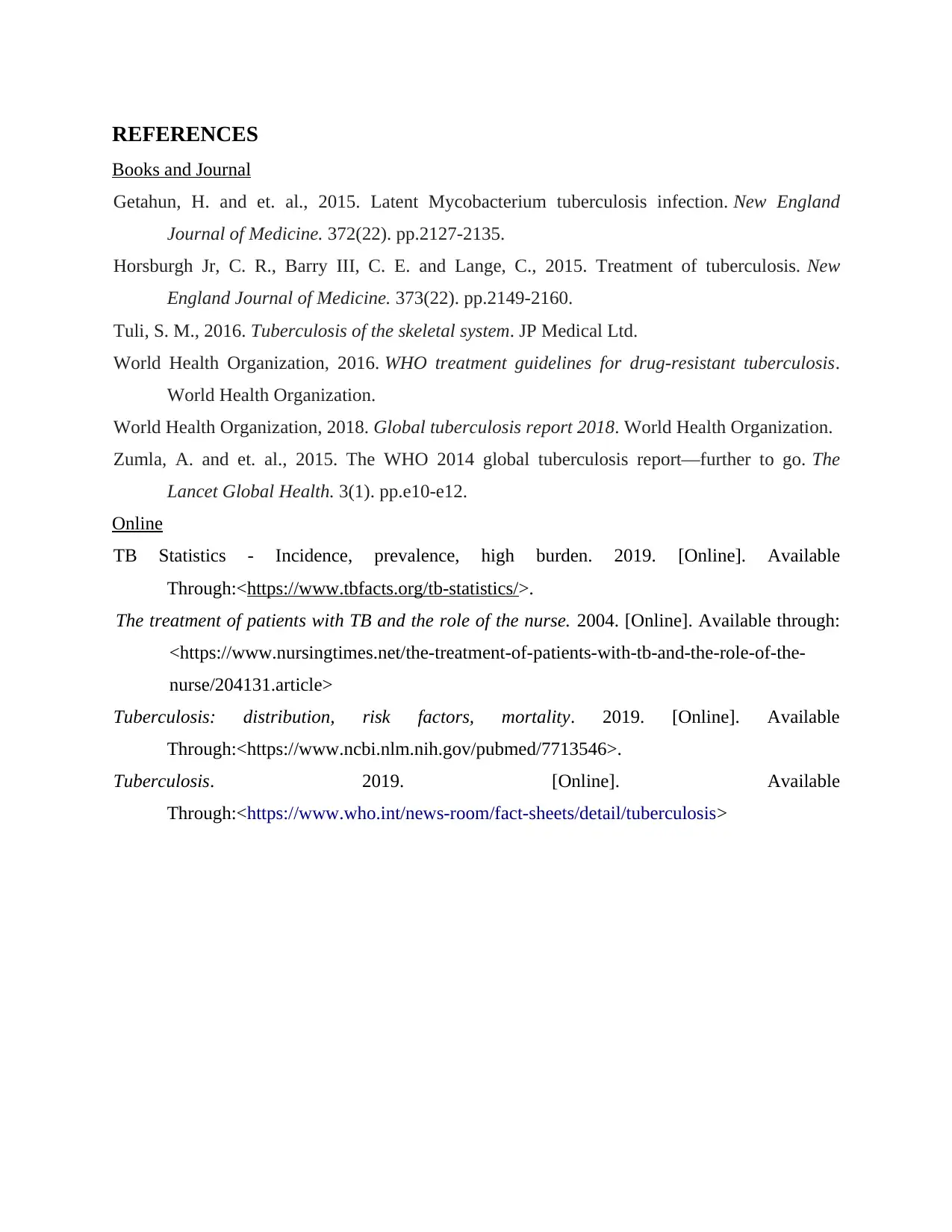
REFERENCES
Books and Journal
Getahun, H. and et. al., 2015. Latent Mycobacterium tuberculosis infection. New England
Journal of Medicine. 372(22). pp.2127-2135.
Horsburgh Jr, C. R., Barry III, C. E. and Lange, C., 2015. Treatment of tuberculosis. New
England Journal of Medicine. 373(22). pp.2149-2160.
Tuli, S. M., 2016. Tuberculosis of the skeletal system. JP Medical Ltd.
World Health Organization, 2016. WHO treatment guidelines for drug-resistant tuberculosis.
World Health Organization.
World Health Organization, 2018. Global tuberculosis report 2018. World Health Organization.
Zumla, A. and et. al., 2015. The WHO 2014 global tuberculosis report—further to go. The
Lancet Global Health. 3(1). pp.e10-e12.
Online
TB Statistics - Incidence, prevalence, high burden. 2019. [Online]. Available
Through:<https://www.tbfacts.org/tb-statistics/>.
The treatment of patients with TB and the role of the nurse. 2004. [Online]. Available through:
<https://www.nursingtimes.net/the-treatment-of-patients-with-tb-and-the-role-of-the-
nurse/204131.article>
Tuberculosis: distribution, risk factors, mortality. 2019. [Online]. Available
Through:<https://www.ncbi.nlm.nih.gov/pubmed/7713546>.
Tuberculosis. 2019. [Online]. Available
Through:<https://www.who.int/news-room/fact-sheets/detail/tuberculosis>
Books and Journal
Getahun, H. and et. al., 2015. Latent Mycobacterium tuberculosis infection. New England
Journal of Medicine. 372(22). pp.2127-2135.
Horsburgh Jr, C. R., Barry III, C. E. and Lange, C., 2015. Treatment of tuberculosis. New
England Journal of Medicine. 373(22). pp.2149-2160.
Tuli, S. M., 2016. Tuberculosis of the skeletal system. JP Medical Ltd.
World Health Organization, 2016. WHO treatment guidelines for drug-resistant tuberculosis.
World Health Organization.
World Health Organization, 2018. Global tuberculosis report 2018. World Health Organization.
Zumla, A. and et. al., 2015. The WHO 2014 global tuberculosis report—further to go. The
Lancet Global Health. 3(1). pp.e10-e12.
Online
TB Statistics - Incidence, prevalence, high burden. 2019. [Online]. Available
Through:<https://www.tbfacts.org/tb-statistics/>.
The treatment of patients with TB and the role of the nurse. 2004. [Online]. Available through:
<https://www.nursingtimes.net/the-treatment-of-patients-with-tb-and-the-role-of-the-
nurse/204131.article>
Tuberculosis: distribution, risk factors, mortality. 2019. [Online]. Available
Through:<https://www.ncbi.nlm.nih.gov/pubmed/7713546>.
Tuberculosis. 2019. [Online]. Available
Through:<https://www.who.int/news-room/fact-sheets/detail/tuberculosis>
⊘ This is a preview!⊘
Do you want full access?
Subscribe today to unlock all pages.

Trusted by 1+ million students worldwide
1 out of 9
Related Documents
Your All-in-One AI-Powered Toolkit for Academic Success.
+13062052269
info@desklib.com
Available 24*7 on WhatsApp / Email
![[object Object]](/_next/static/media/star-bottom.7253800d.svg)
Unlock your academic potential
Copyright © 2020–2025 A2Z Services. All Rights Reserved. Developed and managed by ZUCOL.





